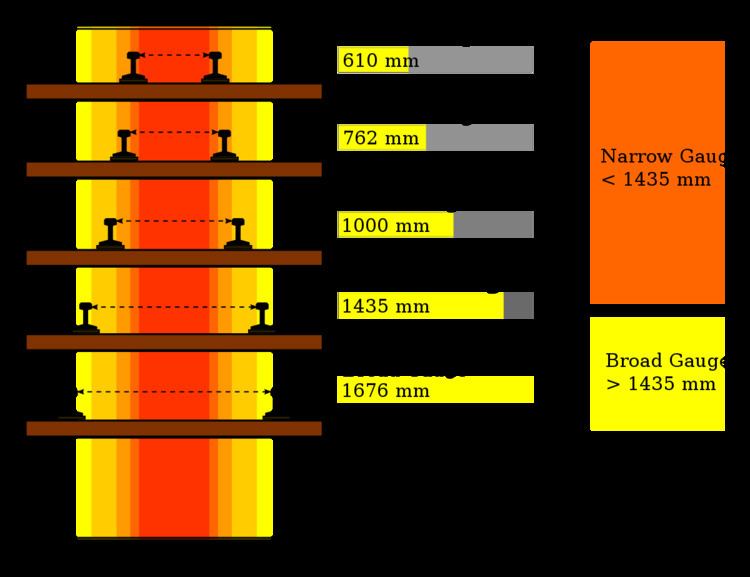 | ||
Project Unigauge, started in 1991, is an ongoing exercise by Indian Railways to convert almost all of the rail gauges in India to 1,676 mm (5 ft 6 in) broad gauge.
Contents
Background
Narrow-gauge railways were built in India in early years as they cost less to build as they are usually lighter in construction, used smaller cars and locomotives (smaller loading gauge), as well as smaller bridges, smaller tunnels (smaller structure gauge) and tighter curves. Narrow gauge was thus used in mountainous terrain, where the savings in civil engineering work could be substantial. It was also used in sparsely populated areas where the potential demand is too low for broader gauge railways to be economically viable.
But by early 90's, the Indian Railways concluded that the advantages of uniformity and interchangeability were judged to outweigh any other possible benefits arising from the use of diverse gauges. Also narrow-gauge railways were deemed too costly to operate and maintain. Also to handle heavier, faster traffic, narrow-gauge railways were considered impractical to improve. In 1991, these led the Indian Railways to implement Project Unigauge which standardises most of the rail gauges in India to 1,676 mm (5 ft 6 in) broad gauge.
Heritage Lines
Four narrow-gauge lines which are declared as heritage lines will not be converted to broad gauge. These are:
A proposal has been passed to convert Kangra Valley Railway (which was previously supposed to be a heritage line) into broad gauge but no work has been started yet.
Urban rail lines
Urban rail transit lines (except suburban rail which are already in broad gauge) which serve the urban areas were built or are being built in standard gauge only and will not be converted to broad gauge. These encompass metro, monorail and trams.
2017
- Bareilly City - Ramganga (9 km) in UP
- Punalur-Edamon (10 KM) in Kerala
- Sengottai-Aryankavu (14 KM) in Tamil Nadu/Kerala
- Ratangarh - Sardarshahar (46 KM) in Rajasthan
- Pollachi - Podanur (40 KM) in Tamil Nadu
- Pilibhit - Majhola Pakarya (26 km) [1]
- Ahmedpur - pachandi (39 KM) (West Bengal) [2]
- Sukrimangla - Ghansor (35 km) (Madhya Pradesh)
2016
- Badarpur - Agartala (227 km) in Assam/Tripura [3]
- Silchar - Jiribam (50 km) in Assam/Manipur
- Katakhal - Bairabi (84 km) in Assam/Mizoram [4]
- Indore - Mhow (21 km) in Madhya Pradesh [5]
- Hanumangarh - Sadulpur (172 km) in Rajasthan [6]
- Banmankhi - Purnia in Bihar (36 km) [7]
- Thawe - Chhapra (107 km) in Bihar [8]
- Kotturu - Gunda Road (52 km) (Karnataka) [9]
- Jabalpur - Sukrimangla (43 km) (Madhya Pradesh)
- Maishashan - Karimganj (11 KM) (NFR) [10]
- Bhojipura - Pilibhit (39.03 km)
2015
- North Lakhimpur - Murkongselek (154 km) in Assam [11][12]
- Balipara - Bhalukpong (34 km) in Assam [13]
- Lumding - Silchar (210 km) in Assam [14]
- Pollachi - Palakkad (55 km) in Tamil Nadu/Kerala [15]
- Sikar - Loharu (122 km) in Rajasthan [16]
- Gonda - Barhni (107 km) in Uttar Pradesh
2014
- Raxaul - Chauradano (24 km) in Bihar
- Palani - Pollachi (63 km) in Tamil Nadu [17]
- Fatehabad - Indore Junction (35 km) in Madhya Pradesh [18]
- Ankleshwar - Rajpipla (63 km) in Gujarat [19]
- Bareilly - Kasganj (106 km) in Uttar Pradesh [20]
- Rangapara North - Tezpur (27 km) in Assam
- Dauram Madhepura - Banmankhi (42 km) in Bihar
- Rangiya - Rangapara North (122 km) in Assam
- Rangapara North - Harmuti (143 km) in Assam
2013
- Ratlam – Fatehabad (85.74 km) in Madhya Pradesh [21]
- Virudhunagar – Manamadurai (66 km) in Tamil Nadu [22]
- Kolar – Chikbalapur (85 km) in Karnataka [23]
2012
- Bareilly City - Lalkua in Uttar Pradesh
- Mayiladuturai – Thiruvarur in Tamil Nadu
2010
- Kanpur Central - Farukkhabad in Uttar Pradesh
- Degana – Ratangarh in Rajasthan
- Ratangarh - Sadulpur in Rajasthan
- Bhildi - Samdari in Rajasthan
- Pakala - Dharmavaram in Andhra Pradesh
- Vellore - Villupuram in Tamil Nadu
Before 2010
- Phulera – Ringas – Rewari in Rajasthan/Haryana
- Guntakal - Kalluru in Andhra Pradesh
- Mathura – Kasganj in Uttar Pradesh
